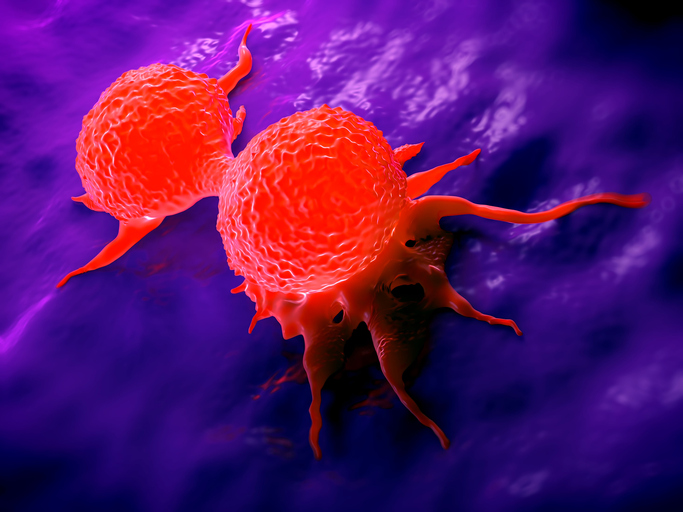
The OncoArray consortium, which includes more than 550 researchers at 300 research facilities around the world, has identified 72 new gene variants that predispose to breast cancer, via a genome-wide association study (GWAS) using the data of more than 275,000 women. Many of the variants lie in regulatory, rather than coding regions, and an additional seven variants are specific for estrogen receptor-negative (ER-negative) breast cancer. The consortium hopes the GWAS findings will provide new insights into the genetic basis of breast cancer, as well as open up new avenues for research into early diagnosis, treatment, and potentially prevention of breast cancer, particularly for hormone therapy–resistant, ER-negative disease.
“These findings add significantly to our understanding of the inherited basis of breast cancer,” commented Doug Easton, Ph.D., from the University of Cambridge, U.K., one of the lead investigators for the OncoArray consortium, which includes more than 550 researchers at 300 research facilities across the globe. “As well as identifying new genetic variants, we have also confirmed many that we had previously suspected. There are some clear patterns in the genetic variants that should help us understand why some women are predisposed to breast cancer, and which genes and mechanisms are involved.”
The OncoArray consortium’s results are published in Nature (“Association Analysis Identifies 65 New Breast Cancer Risk Loci”) and in Nature Genetics (“Identification of Ten Variants Associated with Risk of Estrogen-Receptor-Negative Breast Cancer”).
Breast cancer risk is known to be influenced by rare coding variants in susceptibility genes such as BRCA1, and by many common, and mostly noncoding, variants, the researchers write in their letter in Nature. However, much of the genetic contribution to the risk of breast cancer isn’t known. The team carried out a GWAS of breast cancer in 122,977 cases and 105,974 controls of European ancestry, and 14,068 cases and 13,104 controls of East Asian ancestry. Their analyses highlighted 65 new loci associated with an increased overall risk for breast cancer. Most of what they describe as the “credible risk single-nucleotide polymorphisms” (SNPs) were in distal regulatory elements, and not in coding regions.
Combining epidemiological with other data the researchers predicted that in many cases the altered genes they identified were the same as those that have been found to drive he growth of breast tumors. “…by integrating in silico data to predict target genes in breast cells at each locus, we demonstrate a strong overlap between candidate target genes and somatic driver genes in breast tumors,” they write. “We estimate that the newly identified susceptibility loci explain around 4% of the twofold familial relative risk of breast cancer and that in total, common susceptibility variants identified through GWAS explain 18% of the familial relative risk.”
The breast cancer risk variants identified are common, with some being carried by more than 50% of all women. But while the risk associated with each risk variant is small, the effects of multiple variants combine to increase the overall risk of breast cancer. An individual’s risk also increases when genetic factors are combined with relevant hormone and lifestyle factors.The researchers estimated that based on all the variants that have been identified to date, about 1 in 100 women have a breast cancer risk that is 3.5 times greater than that of the general population.
Most common breast cancer susceptibility variants have been identified through GWAS of predominantly ER-positive disease. In their Nature Genetics paper, the OncoArray consortium describes a GWAS of 21,468 ER-negative cases and 100,594 controls, combined with 18,908 BRCA1 mutation carriers (9414 with breast cancer), all of whom were of European origin. Their results highlighted 10 new susceptibility variants for ER-negative breast cancer, and also replicated associations with another 10 variants that had previously been reported in GWAS of ER-negative disease or BRCA1 mutation carriers. Most of the new and previously identified variants are associated with ER-negative disease, and not ER-positive breast cancer, highlighting the specific genetic nature of this form of breast cancer. The researchers noted that their study also observed consistent associations with ER-negative disease for another 105 susceptibility variants for breast cancer overall, which had been identified by other studies.
“These 125 variants explain approximately 16% of the familial risk of this breast cancer subtype,” they write. “These findings may lead to improved risk prediction and inform further fine-mapping and functional work to better understand the biological basis of ER-negative breast cancer.”
Roger Milne, Ph.D., at the Cancer Council Victoria in Melbourne, suggests that the OncoArray findings may help to improve risk prediction both for the general population and in particular for carriers of BRCA1 mutations. “A better understanding of the biological basis of ER-negative breast cancer may lead to more effective preventive interventions and treatments,” he commented.
Given the size of their GWAS, the researchers did expect to find many new breast cancer risk variants, “but the studies tell us a lot more about which genes are involved, revealing many previously unsuspected genes and genetic mechanisms underlying breast carcinogenesis,” added Peter Kraft, Ph.D., at Harvard T.H. Chan School of Public Health. “This should provide guidance for a lot of future research.”
The researchers suggest that current screening practice could be changed to take into account these different risks. “Using data from genomic studies, combined with information on other known risk factors, will allow better breast cancer risk assessment, therefore helping to identify a small but meaningful proportion of women at high risk of breast cancer,” stated Jacques Simard, Ph.D., at Université Laval, Quebec City, Canada. “These women may benefit from more intensive screening, starting at a younger age, or using more sensitive screening techniques, allowing early detection and prevention of the disease. At the same time, this personalized information will also be useful to adapt screening modalities for women at substantially lower risk.”











